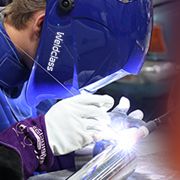Welding Helmet Switching Speeds: The Faster the Better
Why the advertised switching speed on a welding helmet is not the whole story. And what else to look for to choose a safe and compliant welding helmet.
What Is Switching Speed?
Switching speed is the time that it takes an auto-darkening welding helmet lens to switch from the light shade (typically around shade 3-4), to dark shade (can range from 6 to 14 depending on the helmet model), after the sensors detect the welding arc.
The Faster The Better, Right?
For many years, welding helmet switching speeds have been quoted and used as an indication of ‘how safe’ a welding helmet may be for the operator, with the implication that a helmet with a faster advertised speed is likely to be ‘more safe’ than one with a lower advertised speed. This is not necessarily the case.
In many cases, this claimed switching speed is a nominal figure that might be based on factory 'testing' under the most ideal conditions, and to help the helmet to compare favourably against the switching speed claims of other brands.
Also, switching speed is only one aspect of the 'optical' protection provided by a helmet. Just like you wouldn’t judge a motor car just by only looking at it's max rpm, in the same way you can’t judge a welding helmet just by it’s switching speed alone. Let's explain...
So How Do I Know If a Helmet Has a Safe Switching Speed?
The question "is the helmet safe to use?" is best answered by "does it conform to a reputable standard such as AS/NZS 1338.1?". If a helmet has been independently tested and conforms to AS/NZS 1338.1, this indicates that the switching speed is certainly within safe margins.
Providing that switching speeds are within the requirements of AS/NZS 1338.1, whether the speed may be 10x or 100x better/faster than the requirement with the standard, this is irrelevant in regards to safety level simply because the human eye is only able to detect speeds up to a certain point.
The human eye will not notice any difference below around 0.2ms, or in other words anything faster than 0.2ms will feel the same to the operator. So a helmet that has a speed of say 0.1ms will not be safer or 'feel' any different than a helmet with a speed of say 0.2ms.
So What Are The AS/NZS Switching Speed Requirements?
AS/NZS 1338.1 switching speed requirements actually vary depending on what shade the lens is switching from & what shade it is switching to. For example, in the case of a shade 9-13 helmet, with a light shade of 3 or 4, the maximum allowable switching speed varies from 2ms (milliseconds) through to 200ms, which is a very wide margin (Refer to AS/NZS 1338.1 clause 2.4.1).
Switching speeds can also vary depending on ambient temperature.
More reasons why quoting / advertising a single speed 'number' is not the the full story.
Switching Speed Is Meaningless Without Reliable Arc Detection
This is very often overlooked in the whole 'switching speed discussion'.
The most important factor for the welder’s perception of switching speed is the ability of the welding helmet/lens to detect the welding arc in the first place. If a helmet/lens has poor ability to detect the arc and/or the arc cannot be detected at the right time, then of course the lens will not switch when it should, and switching speed becomes almost irrelevant.
TIG, for example, has an initial spark that starts the welding process and ‘ignites’ the arc (occurs when the operator first touches the tungsten electrode on the job, or in the case of machines with HF/High frequency it is when the operator presses to torch trigger to initiate HF start). Many lenses/helmets cannot detect this initial spark but will only detect the stable / much brighter welding arc which occurs some time later, so in this case even if switching speed is 'very fast', it can seem slow to the operator.
Switching Speeds of Weldclass Welding Helmets
All Weldclass helmet models have been independently tested to and conform to and/or exceed the requirements of AS/NZS 1338.1 standard.
All models also offer UV and IR protection in the 'light' mode, which means that even if the lens were to fail to switch to dark, the operator is protected from harmful UV/IR rays that cause permenant damage.
And Weldclass is constantly improving the technology and electronics that drive the arc sensors, for reliable switching even in challenging applications and conditions such as low-amperage TIG welding.
View the Weldclass Helmet Range PAPR Welding Helmets
While all care has been taken to ensure the information presented is accurate, Weldclass accepts no responsibility for any errors or omissions in this article. The information given is of a general nature only intended to provide readers with a basic overview of the topics presented, does not take into account the specific circumstances of any individual application or situation, may be simplified and/or abbreviated, will not be a complete or exhaustive resource, and should not be used as a substitute for professional advice. All applicable standards (including Australian standards), industry guidelines and regulations should be consulted and followed. E.& O.E.



